In this comprehensive guide, we will take you through the essentials of Bitcoin wallets, why they are essential, and how you can choose the best one to safeguard your digital assets. Whether you’re just starting your cryptocurrency adventure or looking to deepen your knowledge, this guide is designed to provide clear, actionable insights.
Understanding the Basics: What is a Bitcoin Wallet?
A Bitcoin wallet acts as a digital vault for your cryptocurrency. It doesn’t store Bitcoin itself, but rather the private keys that grant you access to your Bitcoin address and, consequently, your funds. Think of it as your personal keychain, each key representing access to a different amount of Bitcoin.
There are various types of Bitcoin wallets, each offering different levels of security and convenience. The primary function of any Bitcoin wallet is to keep your private keys safe and accessible only to you. Unlike traditional wallets, Bitcoin wallets can be software-based, hardware-based, or even a simple piece of paper with a printed QR code.
Choosing the right wallet is pivotal, as it directly impacts the security and ease of accessing your Bitcoin. Let’s dig deeper into the types of Bitcoin wallets and understand which might suit your needs best.
Types of Bitcoin Wallets: Hardware, Software, and Paper Wallets
Hardware Wallets
Hardware wallets are physical devices designed to securely store your private keys offline. They are considered one of the most secure options available. Brands like Ledger and Trezor are popular choices among Bitcoin enthusiasts. These wallets require you to connect them to your computer or mobile device when making transactions, ensuring that your keys are safe from online threats.
Software Wallets
Software wallets are applications you can install on your computer or smartphone. They come in two main types—hot wallets and cold wallets. Hot wallets are always connected to the internet, providing easy access to your funds but at a higher risk of hacking. A great example of a beginner-friendly bitcoin wallet is the RockItCoin app.
Paper Wallets
A Bitcoin paper wallet is a physical printout of your public and private keys, often represented as QR codes. This method is highly secure since it keeps your keys offline, but it comes with the risk of losing the paper or getting damaged. Generating and using a paper wallet requires a bit more technical know-how, but it can be a good option for long-term storage.
How to Choose the Best Bitcoin Wallet for You
Choosing the best Bitcoin wallet depends largely on your individual needs and how you intend to use your Bitcoin. If ease of access and frequent transactions are your priority, a hot software wallet might be the way to go. These wallets are user-friendly and perfect for daily use.
If security is your main concern and you plan to store large amounts of Bitcoin, a hardware wallet is your best bet. While they might come with a higher price tag, the peace of mind they offer is unparalleled. For those looking to hold Bitcoin as a long-term investment, a paper wallet could be an excellent choice, provided you take steps to store it securely.
Consider factors such as ease of use, security features, and cost when making your decision. Each type of wallet offers different benefits and risks, so it’s essential to choose one that aligns with your investment strategy and comfort level with technology.
Setting Up and Securing Your Bitcoin Wallet
Setting up a Bitcoin wallet is relatively straightforward, but securing it requires vigilance. For hardware wallets, follow the manufacturer’s instructions to initialize the device and create a recovery phrase. This phrase is crucial—it’s your backup if the device is lost or damaged. Store this phrase in a safe place, not digitally.
For software wallets, download the application from a reputable source and follow the setup instructions. Create a strong, unique password and enable two-factor authentication (2FA) if available. Regularly update your software to protect against vulnerabilities.
When creating a Bitcoin paper wallet, use an offline generator to avoid exposing your private keys to the internet. You can also print a paper wallet if you purchase Bitcoin at a RockItCoin Bitcoin ATM near you. Store the paper wallet in a safe, secure location to prevent loss, damage, or unauthorized access to funds.
How to Send Bitcoin from Your Bitcoin Wallet
Sending Bitcoin from your wallet is a straightforward process. First, you’ll need the recipient’s Bitcoin address, which is typically a string of letters and numbers or a QR code. Open your wallet application and navigate to the ‘Send’ or ‘Withdraw’ feature. Enter the recipient’s Bitcoin address in the designated field and specify the amount of Bitcoin you wish to send. Before confirming the transaction, double-check all details to ensure accuracy, as Bitcoin transactions are irreversible. Once you’re satisfied, authorize the transaction, and it will be broadcast to the Bitcoin network. You should receive a confirmation once it’s processed, which can take anywhere from a few minutes to an hour, depending on network congestion.
How to Receive Bitcoin into Your Bitcoin Wallet
Receiving Bitcoin is equally simple. To provide someone with your wallet address, navigate to the ‘Receive’ or ‘Deposit’ section of your wallet. Here, you will find your Bitcoin address, which can be shared as a string of characters or via a QR code for easier scanning. Ensure you copy the address accurately to avoid any mistakes. Once you have shared the address, the sender can proceed with the transaction. After the funds have been sent, you will receive a notification in your wallet when the transaction is confirmed, allowing you to see your updated balance. Remember that due to potential network delays, the funds may not appear immediately, so patience is often required.
The Future of Bitcoin Wallets and the Importance of Security Measures
The future of Bitcoin wallets looks promising, with advancements aimed at enhancing security and user experience. Developers are constantly working on integrating more robust security features, such as multi-signature transactions, where multiple keys are required to authorize a transaction, adding an extra layer of security.
Innovations in user interfaces are also making Bitcoin wallets more accessible to the average user. Features like biometric authentication and seamless integration with other financial services are becoming more common, bridging the gap between traditional banking and cryptocurrency.
Security measures will continue to be of paramount importance. Always stay informed about the latest security practices and updates from wallet providers. Remember, the security of your Bitcoin largely depends on your vigilance and the measures you take to protect your private keys.
The RockItCoin App is Perfect for Beginners
For those new to the world of Bitcoin, the RockItCoin app offers an excellent starting point. It combines ease of use with robust security features, making it ideal for beginners. The app provides intuitive navigation and instant access to a variety of cryptocurrency wallets.
You can also buy Bitcoin with a credit and debit card and find a Bitcoin ATM near you using the RockItCoin app, giving you multiple options for purchasing your first Bitcoin.
Conclusion
Bitcoin wallets are an essential tool for anyone looking to invest in cryptocurrency. They provide the means to secure and manage your digital assets effectively. By understanding the different types of wallets and their features, you can choose the one that best fits your needs and investment strategy.
Remember, the key to a successful Bitcoin investment is not just about choosing the right wallet but also staying informed and vigilant about security. Start your Bitcoin adventure confidently with the knowledge and tools provided in this guide. For those ready to take the next step, consider the RockItCoin app as your trustworthy companion in the exciting world of cryptocurrency.








